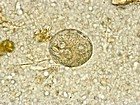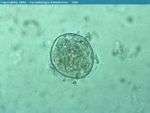Difference between revisions of "Balantidium"
| (12 intermediate revisions by 3 users not shown) | |||
| Line 1: | Line 1: | ||
| − | {{ | + | {{unfinished}} |
| − | |||
| − | |||
| − | |||
| − | |||
| − | |||
| − | |||
| − | |||
| − | |||
| − | |||
[[Image:Balantidium pig.jpg|thumb|right|150px|''Balantidium'' from a pig - Joaquim Castellà Veterinary Parasitology Universitat Autònoma de Barcelona]] | [[Image:Balantidium pig.jpg|thumb|right|150px|''Balantidium'' from a pig - Joaquim Castellà Veterinary Parasitology Universitat Autònoma de Barcelona]] | ||
[[Image:Balantidium pig trophozoite.jpg|thumb|right|150px|''Balantidium'' trophozoite from a pig - Joaquim Castellà Veterinary Parasitology Universitat Autònoma de Barcelona]] | [[Image:Balantidium pig trophozoite.jpg|thumb|right|150px|''Balantidium'' trophozoite from a pig - Joaquim Castellà Veterinary Parasitology Universitat Autònoma de Barcelona]] | ||
| + | [[Image:Balanditium.jpg|thumb|right|150px|Balantidium coli - trofozoite and cyst - Wikimedia Commons]] | ||
| − | + | ''Balantidium'' is a ciliate protozoan found as a commensal in the lumen of the [[Large Intestine - Anatomy & Physiology|large intestine]]. It infects pigs and other animals, including humans. It is the only ciliate known to be pathogenic. | |
| − | ''Balantidium'' is a ciliate | ||
==Identification== | ==Identification== | ||
| − | ''Balantidium'' can be identified by their ciliary organelles on their surface membrances. They are 80μm long and have funnel-shaped depressions leading to the | + | ''Balantidium'' can be identified by their ciliary organelles on their surface membrances. They are 80μm long and have funnel-shaped depressions leading to the cytostome (mouth). ''Balantidium'' has two nuclei, one kidney shaped macronucleus and one small micronucleus. ''Balantidium'' also has contractile and food vacuoles, which is rare in parasitic protozoa. |
==Life Cycle== | ==Life Cycle== | ||
| − | The host ingests a | + | The host ingests a cyst which passes to the small intestine and undergoes encystation to produces trophozoites. The trophozoites remain in the intestinal lumen and reproduce by binary fission. They are then released with the faeces and encyst to form new cysts. The cysts are thick-walled, ensuring infection of a new host. |
==Pathogenesis== | ==Pathogenesis== | ||
| Line 29: | Line 20: | ||
| − | ==Important Species== | + | ===Important Species=== |
*''B.coli'' | *''B.coli'' | ||
| − | :This species is the cause of [[Balantidiasis]], which is pathogenic in humans. | + | ::This species is the cause of [[Balantidiasis]], which is pathogenic in humans. |
| − | |||
| − | |||
| − | |||
| − | |||
| − | |||
| − | |||
| − | |||
| − | |||
| − | |||
| − | |||
| − | |||
| − | |||
| − | |||
[[Category:Miscellaneous Protozoa]] | [[Category:Miscellaneous Protozoa]] | ||
| − | + | [[Category:To_Do_-_AimeeHicks]] | |
| − | [[Category: | ||
Revision as of 09:55, 16 July 2010
| This article is still under construction. |
Balantidium is a ciliate protozoan found as a commensal in the lumen of the large intestine. It infects pigs and other animals, including humans. It is the only ciliate known to be pathogenic.
Identification
Balantidium can be identified by their ciliary organelles on their surface membrances. They are 80μm long and have funnel-shaped depressions leading to the cytostome (mouth). Balantidium has two nuclei, one kidney shaped macronucleus and one small micronucleus. Balantidium also has contractile and food vacuoles, which is rare in parasitic protozoa.
Life Cycle
The host ingests a cyst which passes to the small intestine and undergoes encystation to produces trophozoites. The trophozoites remain in the intestinal lumen and reproduce by binary fission. They are then released with the faeces and encyst to form new cysts. The cysts are thick-walled, ensuring infection of a new host.
Pathogenesis
Pigs are common resevoirs of Balantidium coli. It is usually found as a commensal, but may cause ulceration and dysentery if the intestinal mucosa is damaged already as the parasite will become invasive. Infected pigs shed vast numbers of cysts in their faeces. Human infection can occur via consuming contaminated foodstuffs and contact with infected pig faeces. It causes ulceration and dysentery.
Important Species
- B.coli
- This species is the cause of Balantidiasis, which is pathogenic in humans.

